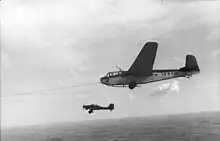Deutsche Forschungsanstalt für Segelflug
The Deutsche Forschungsanstalt für Segelflug (German for 'German Research Institute for Sailplane Flight' / 'German Institute for Glider Research'), or DFS , was formed in 1933 to centralise all gliding activity in Germany, under the directorship of Professor Walter Georgii. It was formed by the nationalisation of the Rhön-Rossitten Gesellschaft (RRG) at Darmstadt.[1]: 76

.png.webp)
The DFS was involved in producing training sailplanes for the Hitler Youth and Luftwaffe, as well as conducting research into advanced technologies such as flying wings and rocket propulsion. Notable DFS-produced aircraft include the DFS 230 transport glider (1600+ produced), the German counterpart to the British Airspeed Horsa glider, and the DFS 194, similar to the famous Messerschmitt Me 163 rocket fighter.
In 1938, following a fatal accident at the Wasserkuppe, DFS held a competition to design a more effective speed brake for gliders. The final design, produced by Wolfgang and Ulrich Hütter of Schempp-Hirth, is used to this day and generally referred to as "Schempp-Hirth airbrakes".
List of some major DFS aircraft projects
- DFS Model 6
- Target glider (prototypes only), 1936
- DFS Model 12
- see Argus As 292 1937
- DFS 39
- Lippisch-designed tail-less research aircraft
- DFS 40
- Lippisch-designed tail-less research aircraft
- DFS 193
- experimental aircraft
- DFS 194
- rocket-powered research aircraft, forerunner of Me 163
- DFS 228
- HIGH-ALTITUDE rocket-powered reconnaissance aircraft (prototype only)
- DFS 230
- transport glider (1600 produced)
- DFS 331
- transport glider (prototype)
- DFS 332
- DFS 346
- supersonic research aircraft
- Stamer-Lippisch Zögling 1
- basic trainer
- DFS Hangwind
- (Ridge Lift), basic trainer (twin boom)
- DFS Professor
- high-performance sailplane
- DFS E 32
- sailplane
- Einheitsschulflugzeug
- (Standard Flight Trainer), glider, basic flight trainer (foldable tail)
- DFS Fliege IIa
- (Fly), sailplane
- DFS Jacht 71
- Amphibious sailplane
- DFS Condor
- high-performance sailplane
- DFS Rhönadler
- (Eagle of the Rhön), high-performance sailplane
- DFS Stanavo
- high-performance sailplane
- DFS Weihe
- high-performance sailplane
- DFS Zögling 33
- basic training glider
- DFS Hol's der Teufel
- (To Hell With It!), training glider
- DFS Moazag'otl
- high-performance sailplane
- DFS Rhönbussard
- sailplane
- DFS São Paulo
- high-performance sailplane
- DFS Präsident
- (President), high-performance sailplane
- DFS Rhönsperber
- high-performance sailplane
- DFS Zögling 35
- updated version of the Zögling basic trainer
- DFS Habicht
- aerobatic sail-plane
- DFS Kranich
- (Crane), two-seat sailplane
- Schulgleiter 38
- basic training glider
- DFS B6
- high-performance sailplane
- DFS Ha III
- high-performance sailplane
- DFS Reiher
- high-performance sailplane
- DFS Olympia Meise
- high-performance sailplane
- DFS Seeadler
- (sea eagle), flying boat sailplane
- DFS Rammer
- aerial ramming plane project powered by a solid rocket engine
- DFS Eber
- parasite fighter project
Legacy of the DFS
The modern DLR still does research into gliding flight, as the DFS once did. An example of this is their enlarged 17-meter wingspan Glaser-Dirks DG-300 Elan high-performance glider, used to precisely set and measure comparative glider performance parameters. [2]
See also
References
- Reitsch, H., 1955, The Sky My Kingdom, London: Biddles Limited, Guildford and King's Lynn, ISBN 1853672629
- "DLR Home — Aeronautics — Research Aircraft: DG 300 Elan-17". dlr.de. Deutsches Zentrum für Luft- und Raumfahrt e.V. (DLR). April 21, 2011. Retrieved November 13, 2013.